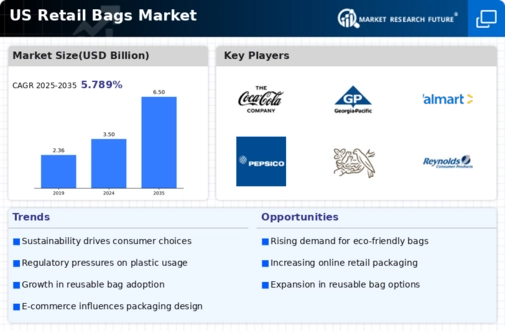Consumer Demand for Convenience
The retail bags market is experiencing a notable surge in consumer demand for convenience-driven products. As lifestyles become increasingly fast-paced, consumers are seeking bags that offer ease of use and portability. This trend is reflected in the growing popularity of lightweight, foldable, and reusable bags, which cater to on-the-go shopping habits. According to recent data, the convenience segment accounts for approximately 35% of the retail bags market, indicating a strong preference for products that simplify the shopping experience. Retailers are responding by expanding their offerings to include a variety of convenient bag options, thereby enhancing customer satisfaction and loyalty. This shift towards convenience is likely to continue shaping the retail bags market, as consumers prioritize functionality alongside aesthetics.
Branding and Marketing Strategies
Branding and marketing strategies are increasingly influencing the retail bags market. Retailers are recognizing the potential of bags as a branding tool, utilizing them to enhance brand visibility and customer engagement. Custom-designed bags that feature logos and unique designs are becoming a popular choice among businesses looking to differentiate themselves in a competitive landscape. Recent surveys indicate that approximately 60% of consumers are more likely to purchase from brands that offer distinctive packaging. This trend is prompting retailers to invest in high-quality, visually appealing bags that not only serve a functional purpose but also act as a marketing asset. As branding continues to play a pivotal role, the retail bags market is likely to see a rise in demand for customized solutions.
E-commerce Growth and Packaging Needs
The rapid expansion of e-commerce is significantly influencing the retail bags market. As online shopping continues to gain traction, the demand for effective packaging solutions is on the rise. Retailers are increasingly utilizing bags that are not only durable but also visually appealing to enhance the unboxing experience for consumers. Data suggests that e-commerce sales in the US have grown by over 20% in the past year, leading to a corresponding increase in the need for retail bags that can withstand shipping and handling. This trend is prompting manufacturers to innovate and develop bags that meet the specific requirements of e-commerce, such as lightweight materials and eco-friendly options. Consequently, the retail bags market will likely evolve in response to these changing packaging needs.
Environmental Regulations and Compliance
Environmental regulations and compliance are increasingly shaping the retail bags market. As governments and regulatory bodies implement stricter guidelines regarding plastic usage and waste management, retailers are compelled to adapt their packaging strategies. The introduction of bans on single-use plastic bags in several states has led to a significant shift towards alternative materials, such as paper and reusable bags. Data indicates that compliance with these regulations has resulted in a 25% increase in the production of eco-friendly bags over the past year. Retailers are not only focusing on meeting regulatory requirements but are also leveraging these changes to enhance their brand image and appeal to environmentally conscious consumers. This regulatory landscape is likely to continue influencing the retail bags market, driving innovation and sustainability.
Technological Advancements in Manufacturing
Technological advancements in manufacturing processes are playing a crucial role in shaping the retail bags market. Innovations such as automated production lines and advanced materials are enabling manufacturers to produce bags more efficiently and sustainably. For instance, the introduction of biodegradable materials has gained traction, appealing to environmentally conscious consumers. Recent estimates indicate that the use of sustainable materials in bag production has increased by approximately 15% over the last year. This shift not only meets consumer demand for eco-friendly options but also enhances the overall quality and durability of retail bags. As technology continues to evolve, it is expected that the retail bags market will witness further improvements in production techniques, leading to a more diverse range of products.























Leave a Comment